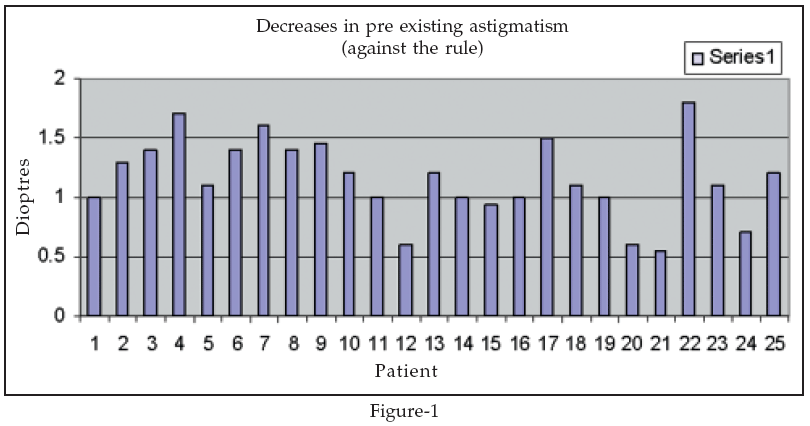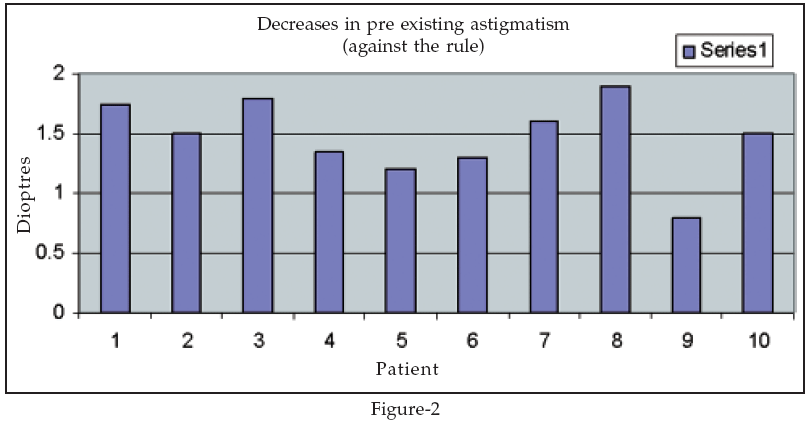|
|
||||
|
Published by : PROFESSIONAL MEDICAL PUBLICATIONS |
||||
|
ISSN 1681-715X |
||||
|
||||
|
- |
||||
|
ORIGINAL ARTICLE |
||||
|
- |
||||
|
Volume 24 |
April - June 2008 (Part-I) |
Number 2 |
||
|
|
||||
|
|
||||
|
|
||||
|
Published by : PROFESSIONAL MEDICAL PUBLICATIONS |
||||
|
ISSN 1681-715X |
||||
|
||||
|
- |
||||
|
ORIGINAL ARTICLE |
||||
|
- |
||||
|
Volume 24 |
April - June 2008 (Part-I) |
Number 2 |
||
|
|
||||
|
|
||||
Outcome of phaco incision on steepest meridian
in eyes with pre existing astigmatism
Shahzad Iftikhar1, Zeba Ilyas Matin2, Asif Kiani3
ABSTRACT
Objective: To determine keratometric outcome of a 5.5mm self sealing incision on the steepest meridian in eyes with preexisting astigmatism.
Methodology: A prospective study was carried out on 35 eyes with preexisting, with or against the rule astigmatism of 1.5-3.0 D. Bimanual phaco was performed using the incisions of 1.5mm, each approximately 120 degrees apart. The IOL was implanted through a third self sealing limbal incision created on the steepest meridian, which was assessed preoperatively by keratometeric readings. Postoperative automated keratometery was recorded at 12 weeks.
Results: The average reduction of pre-existing against and with the rule astigmatism was 1.15 (SD = 0.33) and 1.47 (SD = 0.32) respectively.
Conclusions: It is possible to achieve negligible or low astigmatic outcomes in eyes with pre-existing with or against the rule astigmatism by predetermining the steepest meridian and placing a third incision of around 5.5mm on the respective meridian.
KEYWORDS: Pre existing astigmatism, Keratometric outcome.
Pak J Med Sci April - June 2008 (Part-I) Vol. 24 No. 2 227-230
1.
Shahzad Iftikhar FRCS,
Fauji Foundation Hospital,
Rawalpindi - Pakistan.
2. Zeba Ilyas Matin FRCS,
Shifa International Hospital,
Islamabad - Pakistan.
3. Asif Kiani FCPS,
Al Shifa Eye Trust Hospital,
Rawalpindi - Pakistan.
Correspondence:
Zeba Ilyas Matin
E-mail: zmatin@hotmail.com
* Received for Publication: October 6, 2007
* Revision Received: October 8, 2007
* Revision Accepted: February 25, 2008
INTRODUCTION
It is every surgeonís goal to achieve a desirable, excellent refractive outcome with minimal induction of astigmatism after cataract surgery. Some of the factors effecting the surgically induced astigmatism (SIA) are the architecture and the location of the incision,
1 the surgical skill, accuracy of biometery and to a great extent on the preexisiting astigmatism (PEA).The advent of small incision surgery and the use of foldable IOLs has successfully managed to control/minimize the SIA, thus providing a good, rapid visual rehabilitation and elliviating the postop spectacle dependence. However postop astigmatism still remains an obstacle in eyes with significant PEA. Numerous studies have been carried out regarding the best possible location, type and width of the incision and their effect on the flattening of the cornea
2 in order to correct / decrease the PEA.The purpose of our study was to see the effect of an incision placed on the steepest meridian in controlling / lowering the astigmatic outcome in eyes with significant amounts of PEA.
METHODOLOGY
In a prospective study 35 eyes had bimanual phaco surgery with implantation of rigid IOL of 5.5mm through a self sealing limbal incision. The mean age of the patients was 65, the range being 60 to 74 years. Twenty five eyes (77.42%) had against, whereas 10 (28.57%) had with the rule astigmatism. Eyes with irregular astigmatism were excluded from the study as were eyes with any other ocular pathology or any systemic disease. Automated keratometery was performed on all eyes preoperatively and the steepest meridian along with the PEA was noted.
Surgical technique: All operations were performed under a peribulbar anesthesia. Two limbal incisions of 1.5mm each were placed for the phaco probe and the irrigating chopper approximately 120 degrees apart. The chamber filled with a viscoelastic and capsulorhexis was performed. After hydrodisection the nucleus was sculpted and emulsified, the remaining cortex aspirated and capsular bag was filled with a viscoelastic. A third self sealing limbal incision of 5.5mm was placed on the steepest meridian and a rigid IOL of 5.5mm placed in the bag. After aspirating the viscoelastic the wound was hydrosealed.
All patients were examined one day, one week and 12 weeks postoperatively. Follow up examination included a complete biomicroscope examination, and visual acuity. Wound was checked for integrity. Any wound related complication was noted. Topical combination of tobramycin 0.5% and dexamethasone 0.1% was administered two hourly for the first week and was tapered off over a 4-6 week period.
RESULTS
Assessment was done one day, three weeks and six weeks post operatively. On each visit a complete slit lamp examination was carried out. Automated keratometery was recorded at 12 weeks and the amount of astigmatism noted. The astigmatic effect was calculated by noting the diference between the pre and postoperative keratometry readings

Twenty five (77.42%) eyes had a preoperative Keratometeric range of preexisting against the rule astigmatism of 42.42-44.12D (mean astigmatism 1.698) and ten (28.57%) eyes had a preexisting with the rule astigmatism of 46.2-44.0 D (mean astigmatism 2.22) whereas there postoperative keratometeric reading in against the rule astigmatism was 42.97-43.51D (mean astigmatism 0.54 D) and in with the rule astigmatism was 43.90-43.15 D (mean astigmatism 0.75) respectively. The results showed an average reduction of 1.15 (SD = 0.33) and 1.47 (SD = 0.32) in against (Fig-1) and with the rule (Fig-2) astigmatism respectively. All wounds were well sealed and no wound related complications were noted.

DISCUSSION
The aim of modern cataract surgery is to achieve a good/desirable refractive outcome postoperatively. There are various factors contributing towards such a result, the induction of minimum amount of SIA, being one of the most vital of all.
Postoperative astigmatism is dependent on factors like the site and width of the incision. In eyes with negligible amounts of PEA the surgical outcome is/can be successfully controlled by manipulating the incision. For example placing the incision in the temporal meridian induces significantly lesser amounts of astigmatism than nasal and supero temporal incisions, probably as they are located further away from the central cornea
3-6 while superiorly placed incisions induce the most astigmatism as they are effected by factors like the movement of eyelids.7,8 Likewise clear corneal incisions minimize the SIA compared to scleral.9 Studies have also shown the importance of corneal relaxing incisions peroperatively, in order to minimize the astigmatism further.10 Apart from the location and site of the incision, the width of the incision also plays a vital role in the induction of postoperative astigmatism. All incisions lead to certain degree of flattening in that meridian, which increases with the increase in the size of the incision.2 4.0-5.0mm incisions lead to greater wound related flattening compared to 3.0mm incisions (hence a greater amount of astigmatism).11-13 Based on this effect 5.2mm incisions lead to greater amounts of astigmatism than 3.2mm incisions.14 Although the advent of small incision surgery using foldable IOLs has been revolutionary, the surgical outcome varies greatly with the amount of PEA15 which is still a complex hurdle.. Work has been carried out to show that no eye of more than 1.2D astigmatism preoperatively, was astigmatism free postoperatively even when a 3.2mm incision was placed in the steepest meridian unless the incision was widened or a third incision was used.16Placing the incision on the steepest meridian leads to a significant amount of flattening in that meridian and a corresponding steepening in the opposite meridian as discussed above. We utilized this concept in eyes with PEA of 1.5 -3.0 D and placed a 5.5mm selfsealing limbal incision on the steepest meridian to assess the effect of a wide incision on neutralizing the PEA. (if additional astigmatic correcting effect could be achieved).
Our study shows that by placing a wide incision of 5.5mm on the particular steep meridian, it is possible to achieve a relatively low amount of astigmatism or even astigmatic free result post surgically in eyes with PEA of 1.5-3.0D. There was minimal wound manipulation, since it was used only for the insertion of the IOL.
We used rigid IOLs in all cases as we did not see any added advantage of using a foldable IOL and in our setup that proved very cost-effective. However, one major disadvantage of using a rigid IOL is the occurrence of posterior capsular opacification later on but the cost effectiveness of it outweighed that disadvantage. All wounds were well sealed from day one. No wound related complication was noted.
CONCLUSIONS
Our study shows that a wide selfsealing incision of 5.5mm can be used effectively to minimize/decrease the existing preoperative astigmatism of 1.5-3 D, when placed on the steeper meridian. However a long term evaluation/followup will be needed to study the stability of this astigmatic outcome.
REFERENCES
1. Kohnen S, Neuber R, Kohnen T. Effect of temporal and nasal unsutured limbal tunnel incisions on induced astigmatism after phacoemulsification. J Cataract Refractive Sur 2002;28(5):821-5.
2. Kock DD, Haft EA, Gay C. Computerized video karatographic analysis of corneal topographic changes induced by sutured and unsutured 4mm scleral pocket incisions, J Cataract Refractive Surgery 1993;19 Suppl:166-9.
3. Rainer G, Menapace R, Vass C. Corneal shape changes after temperal and superolateral 3.00mm clear corneal incisions. J Cataract Refractive Sur 1999;25(8):1121-6.
4. Steinert RF, Brint SF, White SM, Fine IH. Astigmatism after small incision cataract surgery; a prospective, randomized, multicentre comparison of 4 and 6.5mm incision. Ophthalmology 1991;98(4):417-23.
5. Merriam JC, Zheng L, Urbanowicz J, Zaider M. Change on the horizontal and vertical meridians of the cornea after cataract surgery. Trans Am Ophthalmol Soc 2001;99:187-95; discussion 195-7.
6. Wirbelaver C, Anders N, Pham DT, Wollensak J. Effect of incision location on pre-op oblique astigmatism after scleral tunnel incision. J Cataract Refractive Sur 1997;23(3):365-71.
7. Roman S, Ullern M. Astigmatisme induit par les incisions corneennes superieures et ter la cataracte. J French Ophthalmology 1997;20(4):272-83.
8. Mendivil A. Comparative study of astigmatism through superior and lateral small incisions. European J Ophthalmology 1996;6(4):389-92.
9. Bilinska E, Wesolek-Czernik A, Synder A, Omulecki W. Surgically induced astigmatism after cataract phacoemulsification. Klin Oczna 2004;106(6):756-9.
10. Shen Y, Tong JP, Li YM. Corneal relaxing incision combined with phacoemulsification and IOL implantation. J Zhejiang Uni Sci 2004;5(8):985-8
11. Shepherd JR. Induced astigmatism in small incision cataract surgery. J Cataract Refractive Surgery 1989;15(1):85-8.
12. Oshika T, Tsuboi S, Yaguchi S. Comparative study of IOL implantation through 3.2-5mm incisions. Ophthalmology 1994;101(7):1183-90.
13. Gills JP, Sanders DR. Use of small incisions to control induced astigmatism and inflammation following cataract surgery. J Cataract Refractive Surgery 1991;17 Suppl 740-4.
14. Kondrot EC. Keratometic cylinder and visual recovery following phaco and IOL implantation using a self sealing incision. J Cataract Refractive Surgery 1991;17 Suppl 731-3.
15. Jurowski P. Reasons of post op astigmatism. Klin Oczna 2003;105(1-2):82-5.
16. Matsumoto Y, Hara T, Chiba K, Chikuda M. Optimal incision sites to obtain astigmatism-free cornea after cataract surgery with a 3.2mm sutureless incision. J Cataract Refractive Surgery 2001;27(10):1615-9.
HOME | SEARCH | CURRENT ISSUE | PAST ISSUES
Professional
Medical Publications
Room No. 522, 5th Floor, Panorama Centre
Building No. 2, P.O. Box 8766, Saddar, Karachi - Pakistan.
Phones : 5688791, 5689285 Fax : 5689860
pjms@pjms.com.pk